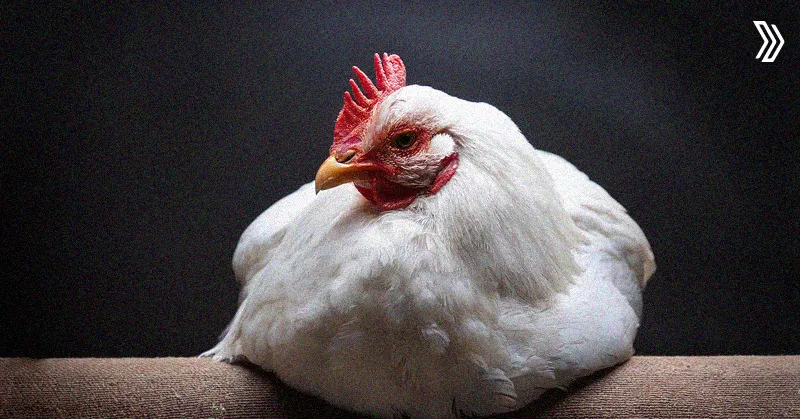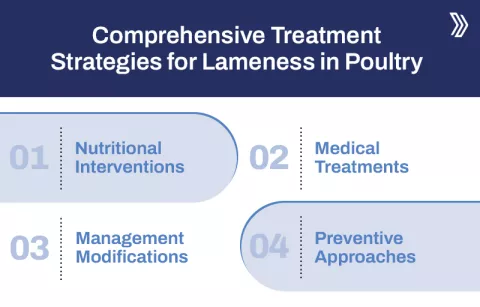Lameness in poultry is an important issue that directly impacts flocks' health, and productivity.
Understanding the causes, prevention, and treatment of lameness, a major concern for commercial and small-scale broiler producers is essential for maintaining a healthy and profitable poultry operation.
What is Lameness in Poultry?
Lameness signifies the condition that impairs a bird's ability to walk normally.
In poultry, particularly in broilers, this condition can worsen and can impact the ability to walk, or complete immobility. It can extend far beyond mere mobility issues – it directly affects bird feed conversion rates, growth performance, and overall farm profitability.
Primary Causes of Lameness in Poultry
1. Genetic Factors
In this modern world, owners want everything fast, so they prefer selective breeds focused on rapid growth and meat production. Choosing these selective breeds has created unique challenges in modern broiler genetics that contribute to lameness.
This fast-growing approach leads to increased flock weight, resulting in skeletal structures that cannot support the birds' rapid muscle development. Consequently, birds develop muscle rapidly while their bones develop slowly, leading to inherent weaknesses in the entire locomotor system.
2. Nutritional Deficiencies
As we all know nutrition is very important in a body, whether it's the human body or bird's body.
The nutrition in the bird's body prevents lameness as it provides crucial minerals to skeletal health. The deficiency of these nutrients can overall impact bone development and structural integrity, some of the important nutrients that are required by the body are calcium, phosphorus, and Vitamin D3 levels. If these nutritional vitamins and minerals are not there then it can result in various lameness conditions
3. Infectious Diseases
Infectious agents can cause diseases that are big threats to poultry mobility.
Viral and bacterial infections can directly impact joint health and can cause abnormal gait. Conditions such as viral arthritis, mycoplasma synovia, and avian leukosis virus can cause inflammation, joint damage, and severe mobility issues. These infections can spread rapidly, making early detection and intervention crucial for managing lameness.
4. Environmental Conditions
The physical environment of poultry plays a crucial role in preventing lameness. Inappropriate flooring materials, high moisture levels, and poor litter management can directly impact leg health. Some of the environmental conditions that can indirectly impact the mobility issue are overcrowding, inadequate ventilation, and stress.
5. Management Practices
Farming approaches significantly influence poultry mobility. Strategies focused solely on rapid weight gain can compromise bird health. Improper feed formulation, insufficient early-life nutrition, and lack of movement opportunities contribute to lameness. Comprehensive management requires a holistic approach that balances growth objectives with bird welfare and natural development processes.
Comprehensive Treatment Strategies for Lameness in Poultry
1. Nutritional Interventions
The main problem of lameness starts with a properly balanced diet. The nutritionist recommends minerals and vitamins in suitable ratios to support skeletal development. Supplements like calcium and phosphorus become very important, and they reduce the occurrence of lameness.
2. Medical Treatments
When lameness occurs, medical interventions become necessary. This includes specific antibiotic treatments for bacterial infections, anti-inflammatory medications, and supportive care for affected birds. Apart from medicines, isolation is also required to stop the infection from spreading and protect the overall flock's health.
3. Management Modifications
Preventing lameness requires comprehensive management strategies. Improved housing design, enhanced ventilation systems, and rigorous health monitoring create environments that are suitable for bird health. Implementing robust biosecurity measures prevents disease introduction and spread.
4. Preventive Approaches
It's always a better choice to take preventive steps before lameness occurs.
Regular veterinary consultations, comprehensive vaccination programs, and strategic genetic selection for robust skeletal structures form the foundation of prevention. By using the poultry management software, you can detect any early signs of the disease and mitigate potential long-term mobility issues.
Lameness represents more than a health challenge – it's an economic concern. Affected birds consume feed without achieving proper growth, reduce overall flock performance, and diminish market value. Each lame bird represents a direct economic loss and a welfare concern that responsible farmers must address.
Ready to unlock the power of Poultry Software lasting profitability? Don't wait any longer!



